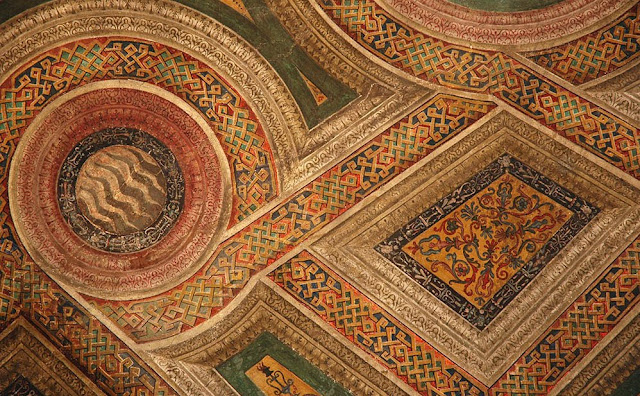

The extension that houses the Vatican picture galleries as they exist now only dates back to the 1930s, those golden Mussolini years when so many good things happened for the Church in Rome. Appropriately then, it was through the intervention of an earlier dictator that the present collection of paintings came into existence at all. This was Napoleon. Most of what currently hangs in the Vatican formerly hung in various Roman churches, commissioned and paid for by various individuals or groups. Napoleon went in and stole all the best stuff his people could locate for the Louvre in the early 19th century. After his defeat in 1815 the Allies returned the lion's share of this booty to the Pope. But the Pope did not return the pictures to the churches. Using Napoleon as his model, he kept them. For all their dicey history, however, this long chain of naturally lighted galleries was absolutely beyond sublime on the afternoon I went there, full of heart-stopping things to look at and plenty of creaky comfortable old wooden chairs to sit in and look at them.

The greatest of all Caravaggios, for example. Some books call it the
Deposition, others the
Descent from the Cross or
Entombment or even
Pietà. According to the argument of the pious (and charming) Vatican guidebook, "as regards the subject, the work is not a burial because the main figures are not portrayed in motion: it is not an actual deposition as the body of Christ is not being lowered into the tomb but laid on a stone slab; and in spite of the presence of the Virgin Mary, it is not a Pietà, given the number of and type of figures present. The moment represented here is that of the deposition of the body of Christ onto the oiling stone ... which forms the ideal base to support and develop the whole group of figures and can be interpreted from a symbolic point of view, given that Christ is referred to in the Sacred Scriptures as the cornerstone on which the Church would be built. "

Facing it across the room – what I had never anticipated – a gorgeous Poussin of similar shape and force,
The Martyrdom of St. Erasmus – much more violent and florid (much more like Caravaggio) than the typical Poussin product. Poussin claimed to resist Caravaggio's influence and to deplore it, but the hanging of the two pieces together proved that he did not resist it consistently.

The Poussin was originally installed as an altarpieces in St. Peter's, until all the paintings in St. Peter's were replaced with mosaic replicas (as above) and then the paintings had to find other homes. Those big mosaic pseudo-paintings in St. Peter's definitely contributed their share to the cold, surreal atmosphere there.
Below, half a dozen more Pinacoteca stars that currently stand at the peak of memory's favor.

Guido Reni
Crucifixion of St Peter

Guercino
Incredulity of St Thomas

Veronese
St Helen Dreaming of the True Cross

Giorgio Vasari
Stoning of St Stephen

Giovanni Bellini
Lamentation

Raphael
Transfiguration
Pope Julius II (sponsor of Michelangelo's work in the Sistine Chapel) wanted not only a fancier chapel for himself but also a suite of rooms freshly decorated for his own use, and Raphael got that job – covering walls and ceiling in fresco. One of those rooms, the Stanza della Segnatura (the place where Julius would formally sign documents) was to me literally unbelievable. I could by contrast believe that I was in the Sistine Chapel, somehow the reality fitted with my expectations, high as they were. But in Raphael's Stanza (several views below) I kept pinching myself to see if I was awake, and I still don't know if I altogether believe I was.

Stanza della Segnatura
Ceiling

Ceiling detail
Judgement of Solomon

Ceiling detail
Adam & Eve

Stanza della Segnatura
Disputation on the Holy Sacrament
 Disputation
Disputation detail
 Disputation
Disputation detail
The main reason Julius II wanted new apartments was that his predecessor Alexander VI was the wicked Rodrigo Borgia, whose name was considered a disgrace throughout the world. The Borgia apartments in the Vatican, which had been elaborately frescoed in the 1490s, were abandoned and remained deserted until the 1880s when Leo XIII (after 400 years) decided the evil spirits had faded enough to permit a restoration job and renewed human habitation. That background made me glad for the chance to wander through the Borgia rooms, even though the style was kind of unappetizing in its archaic stiffness.



After eating a truly terrible panini and drinking a truly terrible cappuccino in the museum cafeteria I staggered outside and grabbed a taxi with a gruff old man driver who would not be persuaded that I could not speak Italian. We conversed in our own version of Italian as he drove me up Via Cola Rienzo which has very fine shops both on the left and on the right – if I understood him correctly.



































































